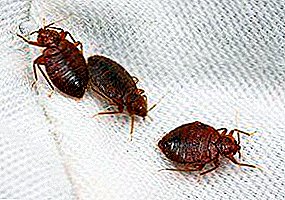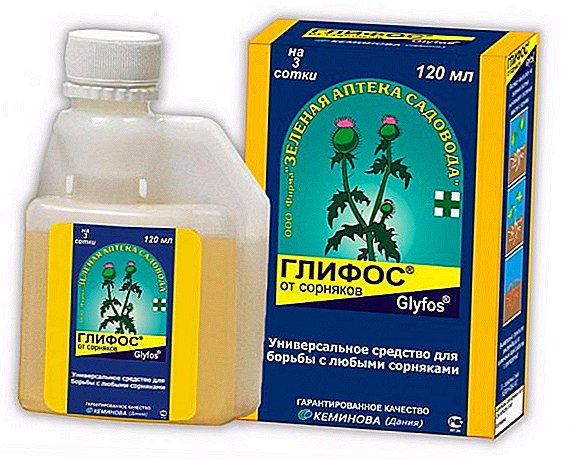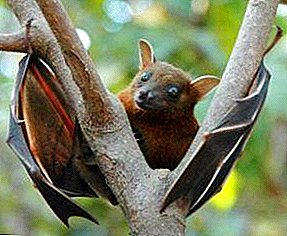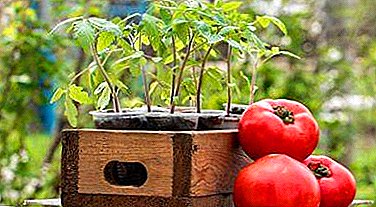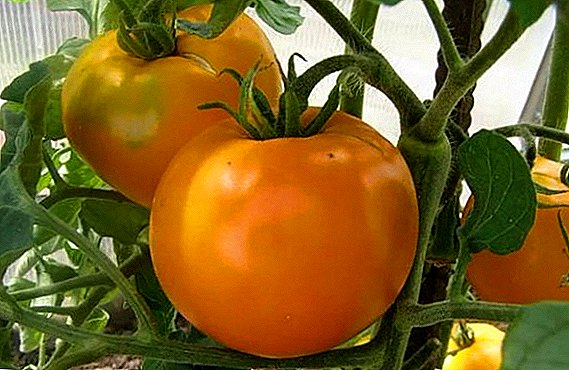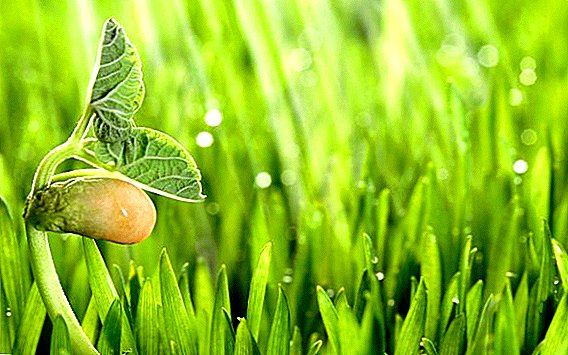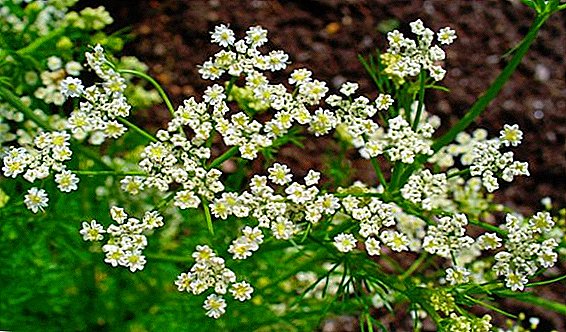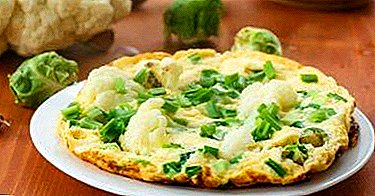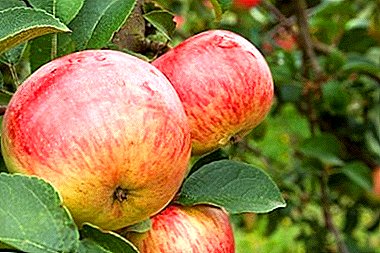
The apple tree is a fruit culture that is very widespread in our country. Surely in every garden grows at least one apple tree.
This fruit plant is very popular and in the southern regions of our country, and in the North. One of the main reasons for this is an extraordinary variety of varieties of apples, adapted to the most diverse conditions.
Description of the characteristics of the apple tree Borovinka variety, features of planting and care, photos of the fruit and how the apple tree looks later in the article.
What kind refers
 The apple tree variety Borovinka sought national love and distribution not only in the open spaces of Russia, but also far beyond its borders.
The apple tree variety Borovinka sought national love and distribution not only in the open spaces of Russia, but also far beyond its borders.
In each country, gardeners gave the name apple in their own way: Duchess of Oldenburg, Kharlamovka, Bravina, Kharlamovskoe, Borovitskaya.
There are many names, but one variety - now we will try to understand its features, walking along the main characteristics.
Borovinka - autumn variety of apple trees, which fruits every year starting at the end of summer and ending at the beginning of autumn.
But the terms of fruit ripening may vary depending on the region of apple cultivation.
In the southern regions, maturity dates are the middle and end of summer; in the middle lane - the beginning of autumn.
Autumn apple varieties include: Volzhanka, Jonathan, Petrova Dessert, Long (Chinese), Zhigulevskoe, Imrus, Calvil Snow, Cinnamon New, Young Naturalist, Uslada, Uspenskoe, Prima, Gift to gardeners, Pepin Shafranny, Freshness, Scala, Flashlight, Eerone , Yantar, Aelita.
Description of the Borovinka variety
Here we describe Borovinka from ground to crown.
In the Borovinka variety, the tree itself can and does reach heights over 4.5 meters.
Round, sparse crown is in diameter of about 5.6 m.
The branches are rarely located on the trunk, they depart from the trunk at an angle in the range from 30 to 45 degrees.
Smooth surface, light articulation - such is their structure; in color - green with a brown tinge. The bark has an olive color.
The shoots are dark brown (it happens that there is a brownish-greenish tint), the buds are well formed, the growth interstices are slightly curved, rather thin, usually long.
 The leaves have a broad oval shape, there is a short sharp tip, the surface is glossy, dark green in color.
The leaves have a broad oval shape, there is a short sharp tip, the surface is glossy, dark green in color.
For this variety of apple trees, a distinctive feature is the characteristic depressions on the leaves (dents) with a diameter of about a pea. Regarding the shoot, the leaves grow at an angle of almost 90 degrees.
Inflorescences - an umbrella. Medium-sized flowers, mostly white, sometimes present a pale pink hue.
The pistil of the flower is small, of the same size as the anthers, it is slightly fused around the base, strongly pubescent in the area of the fork.
Now, finding yourself in an apple orchard, you can easily discern a boletus among the trees of other varieties. And a couple of words about seeds and fruits, so that the recognition was maximum.
The correct rounded shapes of Borovinka fruit have a smooth surface and shine moderately in the sun. The apples are very large, slightly larger than average (weighing about 90 grams each).
IMPORTANT! Borovinka apples are large and heavy, so there are frequent cases when the branches do not hold them, and apples fall.
Fruit pulp is juicy, soft, friable, granular. Yellow with pinkish stains the color of the fetus is rare, mostly it is light green.
On the surface - a small wax coating, while the skin of the fruit is dry and smooth.
 The stem is usually thin and long, light green in color. Seeds are dark brown.
The stem is usually thin and long, light green in color. Seeds are dark brown.
The variety of apples Borovinka is good for consumption "from the branch", directly fresh, and is also suitable for harvesting, being subjected to any processing (drying, processing into juices, jam, wine).
We have just found out what the apple tree looks like now, but it is worth mentioning how it became: the history of creation and the distribution area.
IMPORTANT! Fruits are tender, transportable, so they are preserved very well until the middle of winter.
A photo









Breeding history
To this day, it is not exactly known how the Borovinka apple tree appeared. It is believed that this variety was the result of national selection.
There is the next version: Tula gardener with the name Bravin actively grew these apples - the variety was named in his honor and was named.
A different opinion: the name Borovinka literally means "boron apple", that is, what grew up in a pine forest (coniferous forest).
Place of birth and distribution
 Variety Borovinka is characterized by very vast area of distribution.
Variety Borovinka is characterized by very vast area of distribution.
In Russia, its massive cultivation is observed in many central regions in the Krasnodar Territory, the Caucasus and the Stavropol region.
The uniqueness of apple trees is that the variety is completely unpretentious and in every corner of Russia successfully grows and bears fruit under different climatic conditions.
Now, having told about the tree and the fruit, it's time to tell about how many apples we can get from Borovinka.
Yield
As already noted, Borovinka - an apple tree, the fruits of which ripen every year in the end of summer - early autumn.
The disadvantage of the variety is the frequency of its fruiting. Gardeners should not forget the fact that in order to harvest every year, different varieties of apple trees should grow in the garden.
 Borovinka apple trees are characterized by high yields and precocity.
Borovinka apple trees are characterized by high yields and precocity.
Such fruits can not be consumed and processed.
Therefore, harvesting is so important in a timely manner. Ripening of ripe fruits usually occurs at the end of August.
Of course, immediately after the removal, you want to quickly eat Borovink's apple, but it is noticed that only after a week after the collection, the taste qualities are revealed most clearly.
High yields are distinguished by the following varieties: Avgusta, Antonovka Dessert, Gala, Winter Pear, Cinnamon Striped, Papirovka, Antey, Lyubava, Kuibyshev, Daughter of Pepinchik, Apple Spas, Belfleur Kitayka, Phoenix of Altai, Uralets, Bely Naliv, Lobo, Yandykovo, Wonderful, Phoenix of Altai, Uralets, Bely Naliv, Lobo, Yandykovo, Wonderful, Phoenix of Altai, Uralets, Bely Naliv, Lobo, Yandykovo, Wonderful, Phoenix of Altai, Uralets, Bely Naliv, Lobo, Yandykovskoye, Marvel , Stroyevskoye, Sokolovskoye, Sun, Ural Bulk, Carpet.
Storage
After harvesting a reasonable question arises: how to store the fruit?
Since Borovinka refers to the autumn varieties of apples, with proper care, apples may lie until the end of November - December. To do this, the fruits are stacked in rows, stalk down, in cardboard boxes or wooden boxes.
It is important that the gaps between the boards are either missing or very small. Rows are laid among themselves sawdust hardwood trees. It is also possible to store in plastic bags suspended from the cellar ceiling.
If Borovinka apple trees do not grow in your garden yet, but you have already planned to purchase seedlings, then the following information will be most welcome.
Planting and care
Consider the three main issues when purchasing seedlings:
 Seedlings of this variety are planted in spring or autumn. It is important to have time before the first frost has not manifested itself on the ground or in the air.
Seedlings of this variety are planted in spring or autumn. It is important to have time before the first frost has not manifested itself on the ground or in the air.
In most cases, when choosing saplings, preference is given to biennial plants.
Choice of place: The first criterion is sufficient illumination.
But the bark of the tree can be damaged by excessive sunlight, which is why planting seedlings of this variety of apple trees is produced in places where the illumination with direct sunlight is a few hours a day.
The soil. Apple Borovinka prefers moisture-intensive soil. Loamy, sandy and floodplain soils are suitable for it, as well as leached chernozem.
Boletus can be cultivated on sandy soils, but with good care (periodic fertilization). There must be a weak acidity of the soil - pH 5.6 ... 6.0.
Soil preparation. Manure and humus, in our case, are excellent fertilizer for the land.
Planting seedlings. The ground system should fill the root system completely, the top should be ground down with a foot.
When planting in the ground is unacceptable deeper apple seedlings. Root neck (the place where the root passes into the trunk) be sure to be 5-7 cm above ground level.
The newly planted tree must be watered with 2-3 buckets of water.
Having planted the plant, we should not forget about caring for it.
 Borovina is absolutely unpretentious and in self-care is not demanding. But there is a significant drawback: poor drought resistance of the apple tree, that is, during drought, the still immature fruits are dropped.
Borovina is absolutely unpretentious and in self-care is not demanding. But there is a significant drawback: poor drought resistance of the apple tree, that is, during drought, the still immature fruits are dropped.
That is why you want to direct the growth of apple trees in the right direction.
Under the branches covered with fruits support must be installedor to connect among themselves branches of a tree with the purpose of not assuming their death individually or the death of the tree entirely.
IMPORTANT! The wood on the plants of this apple variety is extremely fragile. With a rich harvest, the branches of trees easily break under the load of fruits, often it leads to the fragility of apple life.
For planting the pollen of another plant is necessary for apples. If the neighbors at the site or in your garden do not have an apple tree of another variety, immediately purchase it.
After all, with the appearance of pollinator, the yield rises by several times even in self-bearing varieties.
In spring, the apple tree should be fed. Top dressing in autumn is not excluded, use various complex fertilizers. necessarily WITHOUT nitrogen. On sandy soils, mostly poor, fertilizers should be applied annually, and on rich lands, frequent top dressing should not be abused.
IMPORTANT: 80 to 100% of the flowers should be cut off in the first year after planting. The survival rate of the tree improves.
In the future, at the stage of "Zelenushki" you need to cut off half the crop - exclusively laid fruits, the size of which is in diameter within a few centimeters. Such an operation is called "yield regulation".
Thanks to her, the tree will be better prepared for winter, the remaining fruits that will hang when ripening will be sweeter and grow to a larger size.
 When watering apple trees, the following arithmetic applies: 4-5 times a month twice a day for one adult tree one bucket of water should fall.
When watering apple trees, the following arithmetic applies: 4-5 times a month twice a day for one adult tree one bucket of water should fall.
When it is fruiting, and this July-August, good watering is extremely important.
If moisture is not enough during this period, then crop losses are possible not only in the current, but also in the next year.
In August, watering should end. Otherwise, the growth of the shoots may turn out to be protracted, this can only have an adverse effect on the winter hardiness of the tree.
However, if the year was dry, then the continuation of watering is badly needed - it helps the tree to be saturated with moisture in the required amount. Naturally, depending on the weather, the irrigation regime will also be adjusted.
Apple Borovinka -frost-resistant variety. However, for the safety of a young tree from early unexpected frosts or snowless winters, horse mulch mulch applied in the area of the circle of the trunk.
Speaking about the care of the apple tree, in a separate paragraph allocated adverse external influences - such as pests and diseases.
Diseases and pests
Gardeners appreciate that Borovinka moderately resistant to pests and various diseases. However, sometimes it is severely damaged. scab But proper prevention and treatment fungicides will not allow scab to spoil the crop.
 Mentioned earlier M. V. Rytov in 1862, according to Lodygin, gave in due time following characteristic: "... It is very true that Borovinka is one of the most common varieties of apples in central Russia; this variety is not very respected, probably because these apples cannot be compared with Antonovkoy and valued much cheaper than her; except fresh consumption, they do not go anywhere and are not so good in the lobe; The tenants, however, do not neglect Borovinka as a cheap apple, which always has a good sale on the spot. It would be more correct to recognize Borovinka apples as suitable only for a lowly taste. "
Mentioned earlier M. V. Rytov in 1862, according to Lodygin, gave in due time following characteristic: "... It is very true that Borovinka is one of the most common varieties of apples in central Russia; this variety is not very respected, probably because these apples cannot be compared with Antonovkoy and valued much cheaper than her; except fresh consumption, they do not go anywhere and are not so good in the lobe; The tenants, however, do not neglect Borovinka as a cheap apple, which always has a good sale on the spot. It would be more correct to recognize Borovinka apples as suitable only for a lowly taste. "
Undoubtedly, some shortcomings are present, but the Borovinka variety is the most valuable of the “starter” crops for breeding. About two dozen new modern varieties were created not without the participation of the apple tree described above: Volga Beauty, Girlfriend, Winter Striped, Zhigulevskoe and others.


